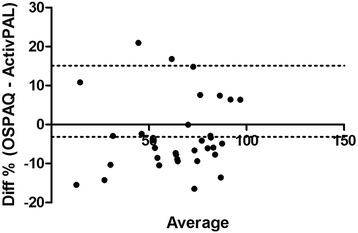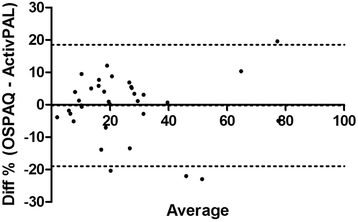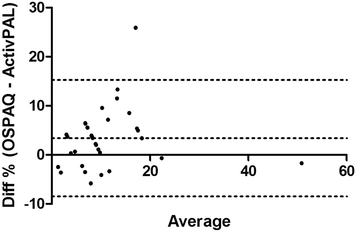Is self-reporting workplace activity worthwhile? Validity and reliability of occupational sitting and physical activity questionnaire in desk-based workers
- PMID: 27542603
- PMCID: PMC4992189
- DOI: 10.1186/s12889-016-3537-4
Is self-reporting workplace activity worthwhile? Validity and reliability of occupational sitting and physical activity questionnaire in desk-based workers
Abstract
Background: With the advent of workplace health and wellbeing programs designed to address prolonged occupational sitting, tools to measure behaviour change within this environment should derive from empirical evidence. In this study we measured aspects of validity and reliability for the Occupational Sitting and Physical Activity Questionnaire that asks employees to recount the percentage of work time they spend in the seated, standing, and walking postures during a typical workday.
Methods: Three separate cohort samples (N = 236) were drawn from a population of government desk-based employees across several departmental agencies. These volunteers were part of a larger state-wide intervention study. Workplace sitting and physical activity behaviour was measured both subjectively against the International Physical Activity Questionnaire, and objectively against ActivPal accelerometers before the intervention began. Criterion validity and concurrent validity for each of the three posture categories were assessed using Spearman's rank correlation coefficients, and a bias comparison with 95 % limits of agreement. Test-retest reliability of the survey was reported with intraclass correlation coefficients.
Results: Criterion validity for this survey was strong for sitting and standing estimates, but weak for walking. Participants significantly overestimated the amount of walking they did at work. Concurrent validity was moderate for sitting and standing, but low for walking. Test-retest reliability of this survey proved to be questionable for our sample.
Conclusions: Based on our findings we must caution occupational health and safety professionals about the use of employee self-report data to estimate workplace physical activity. While the survey produced accurate measurements for time spent sitting at work it was more difficult for employees to estimate their workplace physical activity.
Keywords: Exercise; Physical activity; Sitting behaviour; Workplace.
Figures



Similar articles
-
The occupational sitting and physical activity questionnaire (OSPAQ): a validation study with accelerometer-assessed measures.BMC Public Health. 2020 Jul 6;20(1):1072. doi: 10.1186/s12889-020-09180-9. BMC Public Health. 2020. PMID: 32631292 Free PMC article.
-
Workplace Sitting Breaks Questionnaire (SITBRQ): an assessment of concurrent validity and test-retest reliability.BMC Public Health. 2014 Dec 5;14:1249. doi: 10.1186/1471-2458-14-1249. BMC Public Health. 2014. PMID: 25476788 Free PMC article.
-
Validity of the occupational sitting and physical activity questionnaire.Med Sci Sports Exerc. 2012 Jan;44(1):118-25. doi: 10.1249/MSS.0b013e3182251060. Med Sci Sports Exerc. 2012. PMID: 21659903
-
Perceptions of the acceptability and feasibility of reducing occupational sitting: review and thematic synthesis.Int J Behav Nutr Phys Act. 2018 Sep 18;15(1):90. doi: 10.1186/s12966-018-0718-9. Int J Behav Nutr Phys Act. 2018. PMID: 30227861 Free PMC article. Review.
-
Systematic Review of the Influence of Physical Work Environment on Office Workers' Physical Activity Behavior.Workplace Health Saf. 2022 Feb;70(2):97-119. doi: 10.1177/21650799211039439. Epub 2022 Jan 11. Workplace Health Saf. 2022. PMID: 35014589 Free PMC article.
Cited by
-
Cumulative physical workload and mobility limitations in middle-aged men and women: a population-based study with retrospective assessment of workload.Int Arch Occup Environ Health. 2019 Jul;92(5):651-660. doi: 10.1007/s00420-019-01399-3. Epub 2019 Jan 18. Int Arch Occup Environ Health. 2019. PMID: 30659363 Free PMC article.
-
Cardiovascular Responses to Occupational Physical Activity Are Exaggerated by Work-Related Stress and Low Fitness.J Occup Environ Med. 2024 Oct 1;66(10):e476-e482. doi: 10.1097/JOM.0000000000003183. Epub 2024 Jul 1. J Occup Environ Med. 2024. PMID: 38955811
-
HARTH: A Human Activity Recognition Dataset for Machine Learning.Sensors (Basel). 2021 Nov 25;21(23):7853. doi: 10.3390/s21237853. Sensors (Basel). 2021. PMID: 34883863 Free PMC article.
-
Occupational Physical Activity Habits of UK Office Workers: Cross-Sectional Data from the Active Buildings Study.Int J Environ Res Public Health. 2018 Jun 9;15(6):1214. doi: 10.3390/ijerph15061214. Int J Environ Res Public Health. 2018. PMID: 29890726 Free PMC article.
-
Classifying sitting, standing, and walking using plantar force data.Med Biol Eng Comput. 2021 Jan;59(1):257-270. doi: 10.1007/s11517-020-02297-4. Epub 2021 Jan 8. Med Biol Eng Comput. 2021. PMID: 33420617
References
MeSH terms
LinkOut - more resources
Full Text Sources
Other Literature Sources
Medical

